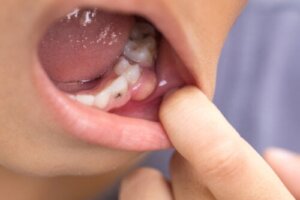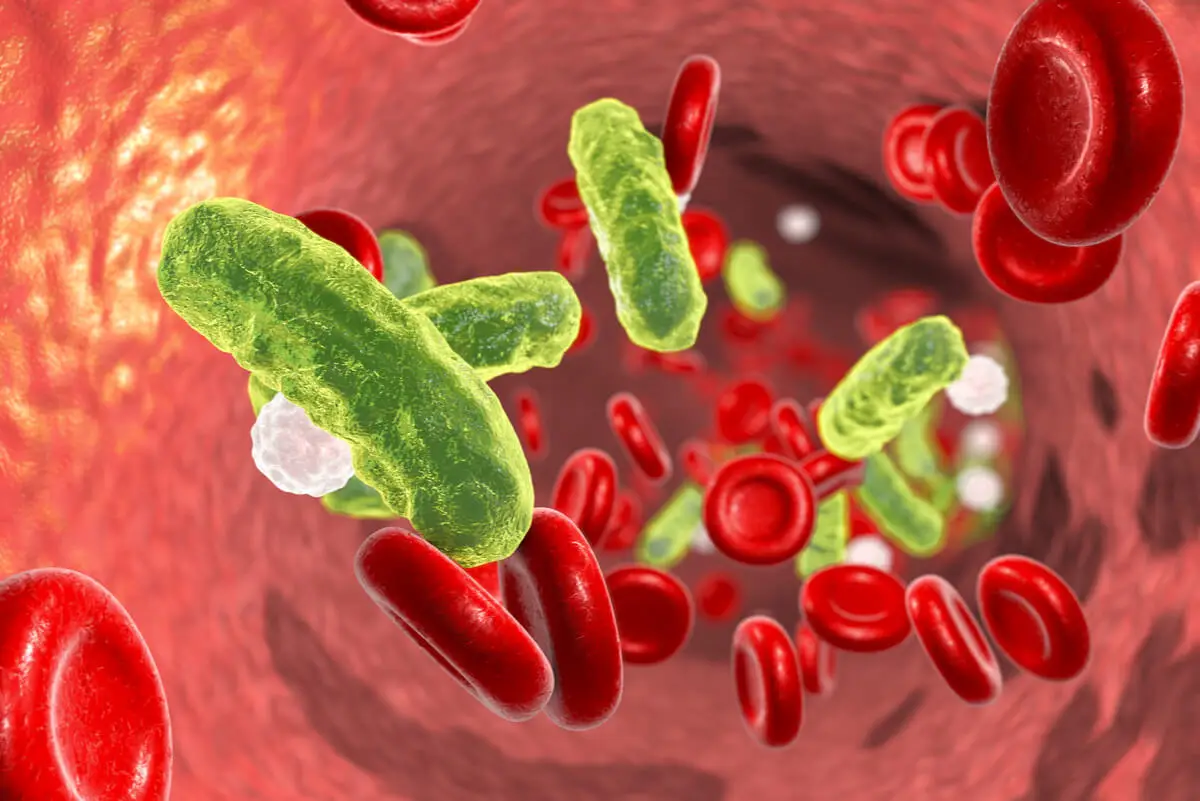Symptoms of a Dental Infection that Has Spread to the Body


Written and verified by the dentist Vanesa Evangelina Buffa
Sometimes, the symptoms of a dental infection aren’t taken seriously. Leaving an infected tooth untreated can have serious and even life-threatening consequences.
In this article, we’re going to discuss the main symptoms of a dental infection. Also, we’ll take about what happens if it spreads through the body and how it can be treated.
What is a dental infection, and what are its symptoms?
A dental infection, also known as a dental abscess, is the accumulation of pus in a tooth due to the entry of bacteria. The microorganisms can enter the tooth through untreated cavities, fractures, cracks, or leaked dental fillings.
The dental infection can be located in different regions of the tooth. If it’s located at the tip of the root, it’s called a root infection or periapical abscess; If it occurs in the gums, on the sides of the root of the tooth, it’s called a periodontal abscess.
Some of the symptoms of a dental infection are the following:
- Pain: This manifests as a throbbing sensation in the tooth and intense, stabbing, persistent pain radiating to the neck, ear, and jaw. It worsens when lying down.
- Sensitivity: Discomfort is felt when chewing, when clenching the teeth, and with hot or cold food.
- Gum lesion: Swelling in the gingival area near the tooth. It looks like a pimple from which pus drains. When it bursts, it may reduce the pain, but it doesn’t mean that the infection has been cured.
- Swelling in the area: There may be an increase in volume in the face or cheeks near the affected tooth.
- Swollen lymph nodes: The nodes of the jaw and neck are swollen and tender to the touch.
- Fever.
- Bad breath and unpleasant taste in the mouth.
- Difficulty in swallowing or breathing.
What are the symptoms of a tooth infection that spreads to the body?
If left untreated, the tooth infection won’t go away. Sometimes, abscesses burst, and the pain goes away, but the bacteria remain inside the tooth, so treatment is still necessary.
Leaving a tooth abscess untreated can have serious consequences, as the infection can spread to other areas, such as the jaw, head, and neck. Bacteria even travel through the bloodstream and cause sepsis (an infection that spreads throughout the body and can be fatal).
The symptoms of a tooth infection that spreads to the body may include the following signs:
- General malaise: The patient presents fatigue, headache, dizziness, and lightheadedness.
- Fever: There may be an increase in body temperature. It’s accompanied by sweating and reddening of the skin or unexplained skin rashes.
- Swelling of the face: There may be an increase in the size of the face, swelling of the floor of the mouth, or infraorbital area. This makes breathing and swallowing difficult. It’s not possible to fully open the oral cavity, and discomfort in moving the tongue. The skin is tight, hot, and painful.
- Dehydration: There’s less frequency of daily urination. There may be painful urination with dark, concentrated urine. The patient may also be confused.
- Increased heart rate: The person’s pulse may be rapid and may be accompanied by chest pain.
- Increased respiratory rate: The person may breathe more than 25 breaths per minute.
- Stomach problems: This includes abdominal pain, vomiting, and diarrhea.

We think you may be interested in reading this, too: LED Teeth Whitening: Advantages, Disadvantages, and Care
How to intervene before these symptoms of dental infection occur
When you feel any pain or discomfort in any dental piece, suffer from dental trauma, or notice a cavity, a hole, or stains on your teeth, the best thing to do is not to let much time pass and consult a dentist to treat the problem before it worsens. Taking an anti-inflammatory medication, avoiding very cold or hot foods, or chewing on the other side of the pain can alleviate the situation, but they’re not a substitute for proper treatment.
When you have symptoms of a dental abscess, it’s important to consult a dentist immediately to treat the infection. In cases where the toothache is accompanied by fever, swelling of the face, and difficulty breathing or swallowing, it’s advisable to go urgently to an emergency room, as these symptoms are indicative that the dental infection has spread to the body.
Possible treatments
To treat the symptoms of a dental infection, the dentist will try to get rid of it by applying some of these options.
Drainage of the abscess
The dentist makes a small incision over the abscess to drain the pus it contains. Pressure is applied to encourage the contents to drain out, and the area is washed with a physiological solution. Sometimes, it’s necessary to leave a rubber drain so that the wound doesn’t close and the material continues to come out.
Root canal treatment
In order to eliminate the infection and preserve the affected tooth, the dentist can perform an endodontic or root canal treatment. This consists of perforating the tooth element until reaching the center of the tooth, where the infected pulp tissue is.
Each canal of the tooth is cleaned and drained with instruments and lavages. Then the canals are filled and sealed. A filling or crown is placed on the tooth to restore its anatomy.
Tooth extraction
In cases where root canal treatment is not possible, the infected tooth must be extracted. The surgery also involves draining the accumulated pus and cleaning the infected area very well.
Antibiotics
Beyond the dental treatment that is established, it’s usually necessary to supplement with the use of antibiotics. This helps to eliminate bacteria, prevent the infection from spreading, and promote recovery.

Hospitalization
Patients with symptoms of a severe dental infection that spreads through the body should be admitted to a hospital and urgently reviewed by a maxillofacial surgeon.
Antibiotics are administered intravenously along with surgical drainage of the abscess. The degree of respiratory disease should be evaluated, and the patient should be monitored for the possibility of sepsis.
Like this article? You may also like to read: 3 DIY Treatments to Remove Tartar from Your Teeth
How to prevent a dental infection
To avoid the appearance of the annoying symptoms of a dental infection, there are certain habits that should be practiced on a regular basis. Proper oral hygiene is the key to a healthy mouth.
Frequent brushing and flossing are necessary to avoid cavities which, if left untreated, can lead to infections. The use of fluoride and a balanced diet with low sugar content will also prevent this tooth disease.
Regular visits to the dentist make a difference. It’s best to get dental checkups every six months.
Letting the symptoms of a dental infection pass by can have serious consequences. In case of any discomfort in the mouth, it is recommended to consult your dentist to immediately deal with the problem before it gets worse.
“]
All cited sources were thoroughly reviewed by our team to ensure their quality, reliability, currency, and validity. The bibliography of this article was considered reliable and of academic or scientific accuracy.
- Bayetto, K., Cheng, A., & Goss, A. (2020). Dental abscess: A potential cause of death and morbidity. Australian Journal of General Practice, 49(9), 563-567. https://search.informit.org/doi/abs/10.3316/INFORMIT.356355593939527
- Burczyńska, A., Strużycka, I., Dziewit, Ł., & Wróblewska, M. (2017). Periapical abscess–etiology, pathogenesis and epidemiology. Przeglad epidemiologiczny, 71(3), 417-428. https://pubmed.ncbi.nlm.nih.gov/29186939/
- Cahill, T., Dayer, M., Prendergast, B., & Thornhill, M. (2017). Do patients at risk of infective endocarditis need antibiotics before dental procedures?. bmj, 358. https://www.bmj.com/content/358/bmj.j3942.abstract
- Costa, L., Vaysse, F., & Maret, D. (2020). Brain abscess secondary to a dental infection. Case Reports in Emergency Medicine, 2020. https://www.hindawi.com/journals/criem/2020/3248174/
- Fernández, M., González, P., Mardones, M., & Bravo, A. (2014). Complicaciones severas de infecciones odontogénicas. Revista Médica Clínica Las Condes, 25(3), 529-533. https://www.sciencedirect.com/science/article/pii/S0716864014700665
- Haque, M., Sartelli, M., & Haque, S. (2019). Dental infection and resistance—global health consequences. Dentistry journal, 7(1), 22. https://www.mdpi.com/2304-6767/7/1/22
- Larena, I., Bartolomé, M., Atance, E., Vara, M., Mur, A., & Blasco, M. (2016). Absceso submandibular producido por caries dental. Pediatría Atención Primaria, 18(71), e107-e110. https://scielo.isciii.es/scielo.php?pid=S1139-76322016000300012&script=sci_arttext&tlng=pt
- López-Fernández, R. M., Téllez-Rodríguez, J., & Rodríguez-Ramírez, A. F. (2016). Las infecciones odontogénicas y sus etapas clínicas. Acta pediátrica de México, 37(5), 302-305. https://www.scielo.org.mx/scielo.php?pid=S0186-23912016000500302&script=sci_arttext
- Mannan, S., Tordik, P., Martinho, F., Chivian, N., & Hirschberg, C. (2021). Dental abscess to septic shock: a case report and literature review. Journal of Endodontics, 47(4), 663-670. https://www.sciencedirect.com/science/article/abs/pii/S0099239920310025
- Menegas, S., Moayedi, S., & Torres, M. (2021). Abscess management: an evidence-based review for emergency medicine clinicians. The Journal of Emergency Medicine, 60(3), 310-320. https://www.sciencedirect.com/science/article/abs/pii/S0736467920311525
- Moratin, J., Freudlsperger, C., Metzger, K., Braß, C., Berger, M., Engel, M., Hoffmann, J., & Ristow, O. (2021). Development of osteomyelitis following dental abscesses—influence of therapy and comorbidities. Clinical Oral Investigations, 25, 1395-1401. https://link.springer.com/article/10.1007/s00784-020-03447-6
- Murillo, C., Previtera, P., de Heredia Monforte, P., & Romero, J. (2023). Mala higiene dental como factor de riesgo para el desarrollo de neumonía aspirativa. A propósito de un caso. Revista Sanitaria de Investigación, 4(9). https://dialnet.unirioja.es/servlet/articulo?codigo=9233001
- Peña, J. (2020). Cirugía de absceso periodontal provocado por un proceso carioso. Dominio de las Ciencias, 6(4), 471-489. http://dominiodelasciencias.com/ojs/index.php/es/article/view/1479
- Saucedo, L., & Fernandéz, L. (2017). Tratamiento de absceso periapical agudo: Reporte de caso clínico. Revista Mexicana de Estomatología, 4(1), 71-72. https://www.remexesto.com/index.php/remexesto/article/view/142
This text is provided for informational purposes only and does not replace consultation with a professional. If in doubt, consult your specialist.








